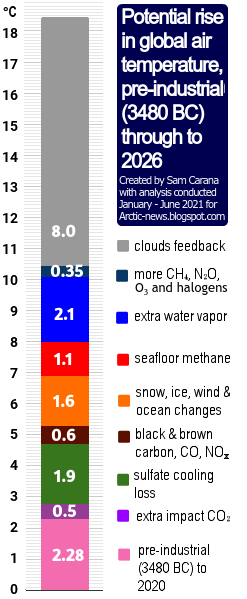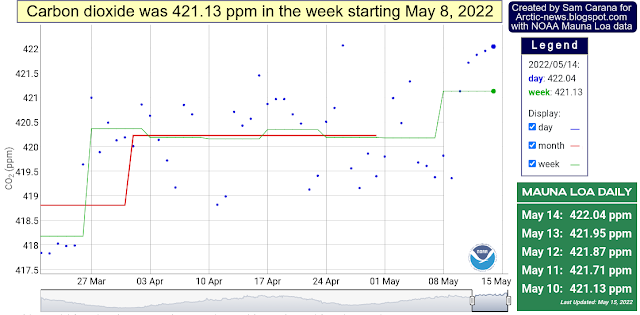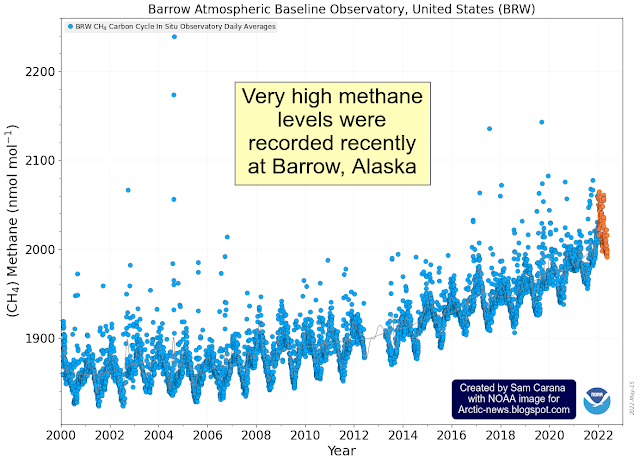NOAA data show a carbon dioxide level of 421.13 parts per million (ppm) for the week starting May 8, 2022, a new record high since measurements started at Mauna Loa, Hawaii. As the image below also shows, very high daily levels were reached recently, as high as 422.04 ppm.
Greenhouse gas levels are even higher further north. Very high carbon dioxide levels were recorded recently at Barrow, Alaska, approaching 430 ppm.
Furthermore, very high methane levels were recorded recently at Barrow, Alaska, including many at levels well over 2000 parts per billion (ppb).
 |
| [ from the Extinction page ] |
Further feedbacks include permafrost degradation, both terrestrial and on the seafloor of the Arctic Ocean, which looks set to cause huge releases of greenhouse gases (particularly CO₂, CH₄ and N₂O).
Temperatures looks set to rise further due to the falling away of sulfate aerosols, while there could be a further temperature rise due to releases of other aerosols that have a net warming impact, such as black and brown carbon, which can increase dramatically as more wood burning and forest fires take place.
As the temperature keeps rising, further self-reinforcing feedbacks will kick in with more ferocity such as an increase in water vapor globally combined with a decrease in lower clouds decks, further increasing the temperature, as described at the clouds feedback page.
Altogether, the global temperature could rise by more than 18°C above pre-industrial, as illustrated by the image on the right from the Extinction page.
Conclusion
In conclusion, temperatures could rise strongly by 2026, resulting in humans going extinct, making it in many respects rather futile to speculate about what will happen beyond 2026.
At the same time, the right thing to do is to help avoid the worst things from happening, through comprehensive and effective action as described in the Climate Plan.
Links
• NOAA - Global Monitoring Laboratory, Recent Daily
https://gml.noaa.gov/ccgg/trends
• NOAA - Global Monitoring Laboratory, at Barrow, Alaska, U.S.
https://gml.noaa.gov/dv/iadv/graph.php?code=BRW&program=ccgg&type=ts
• Arctic Hit By Ten Tipping Points
https://arctic-news.blogspot.com/2020/04/arctic-hit-by-ten-tipping-points.html
• NOAA - El Niño
https://www.noaa.gov/education/resource-collections/weather-atmosphere/el-nino#:~:text=An%20El%20Ni%C3%B1o%20condition%20occurs,every%203%20to%205%20years.
• NOAA - Monthly Temperature Anomalies Versus El Niño
• Sunspots
https://arctic-news.blogspot.com/p/sunspots.html
• Latent heat
https://arctic-news.blogspot.com/p/latent-heat.html
• Blue Ocean Event
• Feedbacks
https://arctic-news.blogspot.com/p/feedbacks.html
• Aerosols
https://arctic-news.blogspot.com/p/aerosols.html
• Clouds feedback and tipping point
https://arctic-news.blogspot.com/p/clouds-feedback.html
• Jet Stream
https://arctic-news.blogspot.com/p/jet-stream.html
• The Importance of Methane
https://arctic-news.blogspot.com/p/the-importance-of-methane-in-climate.html
• When Will We Die?
https://arctic-news.blogspot.com/2019/06/when-will-we-die.html
• Climate Plan
https://arctic-news.blogspot.com/p/climateplan.html
































